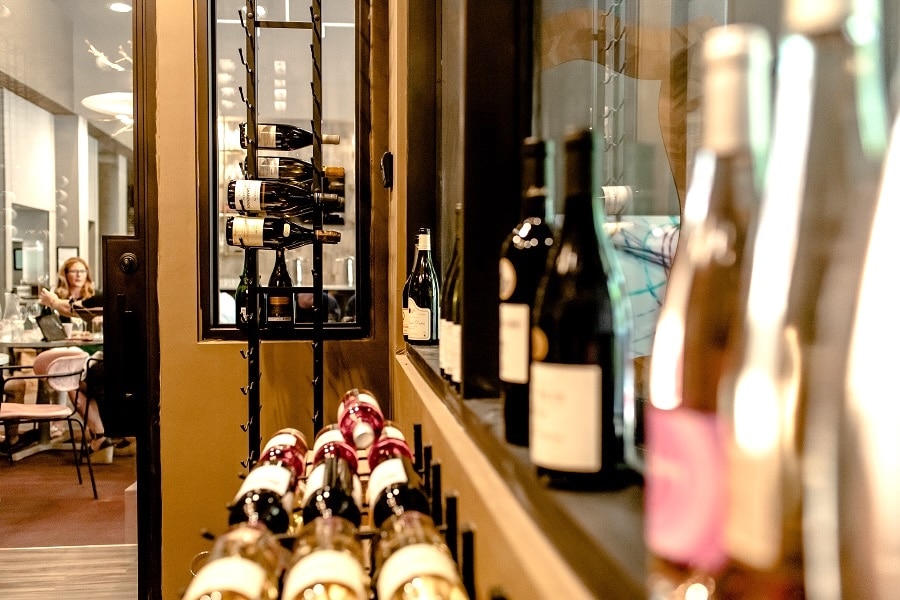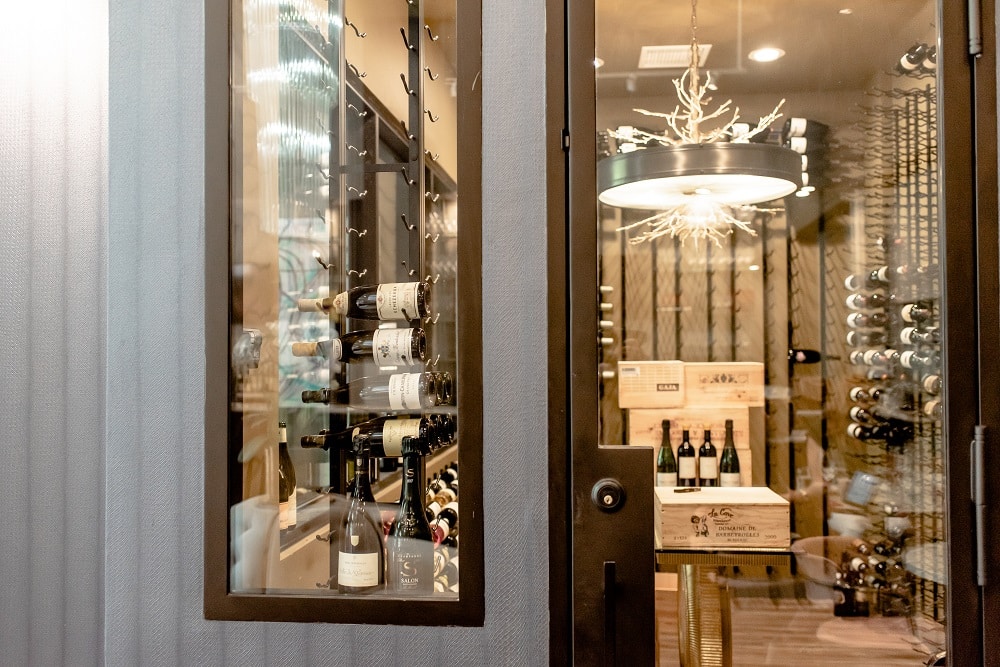A Commercial Wine Room That Steals the Spotlight
A great dining experience deserves more than just good food.
When the owner of a sleek new restaurant called us, he had a clear vision: he wanted a commercial wine room that wasn’t just a backroom storage space; he wanted a wine room that would be the heartbeat of his dining experience. Guests would sip cocktails at the bar, glance over, and immediately be drawn to the glow of bottles behind glass. The cellar needed to be both functional and unforgettable.
We loved the challenge.
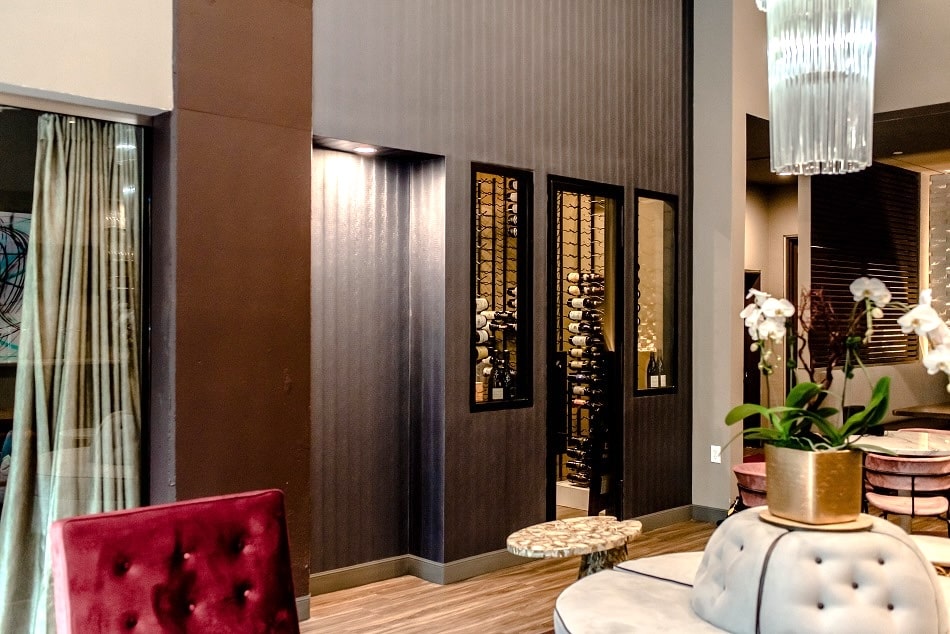
A single tempered glass door and two glass windows allow customers to see inside this commercial wine room.
Designing Commercial Wine Rooms That Tell a Story
From the start, we knew this project was about more than racks and cooling systems—it was about creating a moment. The cellar sits right between the wine bar and a private dining area, which meant it would be on full display. It had to look good, work hard, and set the right mood.
As Robert Stockberger, our lead designer, likes to say:
“Our job is to make people stop mid-conversation and say, ‘What’s in there?’ That’s when you know you’ve created something special.”

Triple-deep, freestanding metal racks allow the owners to easily reconfigure the layout of the wine room.
Design Choices That Made It Shine
Sleek, Floor-to-Ceiling Racks
We went with matte-black metal racking that runs from floor to ceiling, three bottles deep. The look is bold, modern, and space-smart. Every wall has a job to do, even the glass panels beside the door, where we added double-deep racks so bottles are visible from both inside and out.
Glass That Invites You In
The entrance is framed in wood with a tall, insulated glass door and matching panels on each side. From the bar or the private dining room, the collection is always in view. It’s like a jewel box—you can’t help but want a closer look.
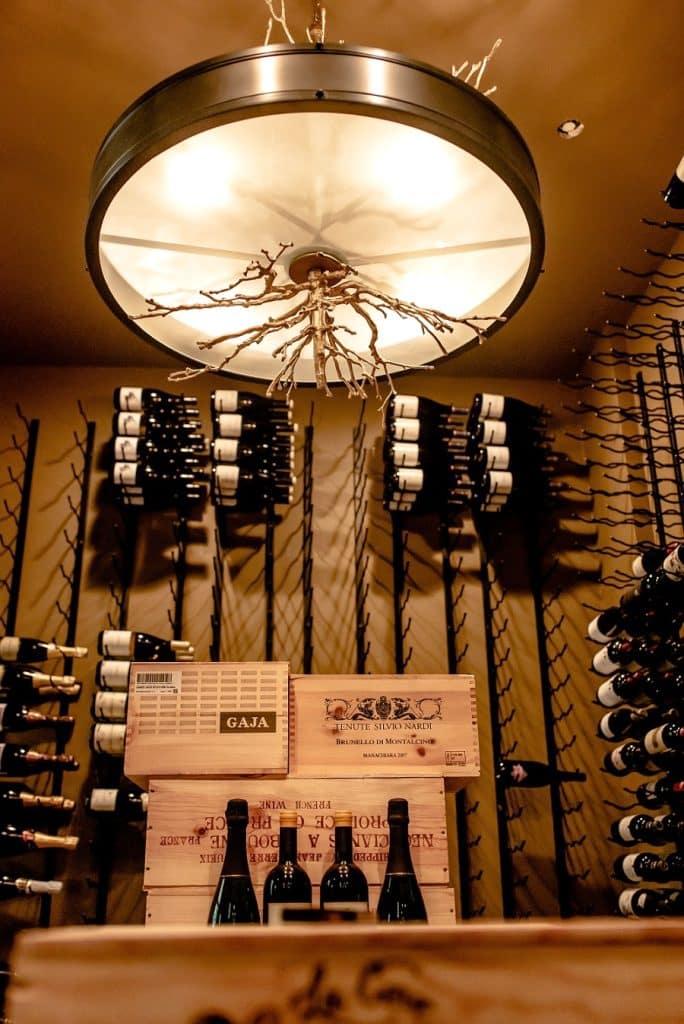
Of course there has to be a custom-made chandelier! This fixture comes with LED light bulbs that help keep the temperature at bay.
Lighting That Sets the Mood
Lighting makes or breaks commercial wine rooms, so we were intentional here. A round chandelier with delicate branch-like arms casts a warm glow in the center of the room, while recessed LED lighting highlights the racks without raising the temperature. The effect is dramatic but welcoming.
“That chandelier was a game-changer,” Robert says. “It gave the cellar a soul, not just light.”
A Table Made for Stories
Toward the back wall, we added a gold-toned table with a mosaic-style base. It’s more than just pretty—it’s practical. Somms can decant or pour right in the cellar, which makes the whole experience more interactive for guests.
The Practical Side: Protecting the Collection
Of course, beauty means nothing if the wine isn’t safe. The area gets hot, and we weren’t about to take risks. We ran a detailed heat-load calculation before installing a cooling system built to keep temperature and humidity rock-steady. The double-paned insulated glass prevents condensation, protecting labels and corks.
For the restaurant, that means no unpleasant surprises—every bottle is poured at its best.
Lessons Learned from This Project
Every project teaches us something new, and this Dallas cellar was no exception. Here are a few takeaways we carry forward into future commercial wine rooms:
- Visibility drives engagement. Positioning the cellar between the bar and private dining area turned it into a built-in marketing tool. Guests couldn’t help but ask about the wines on display.
- Lighting is as important as racking. The chandelier not only illuminated the space but also became part of the restaurant’s identity. Lesson learned: never underestimate the emotional power of good lighting.
- Function meets theater. Adding the tasting table inside the cellar gave staff a stage to interact with guests, elevating the experience and making wine service more memorable.
- Climate precision is non-negotiable. In Dallas’s warm climate, we were reminded once again that top-tier cooling and insulation are critical for protecting every bottle and the reputation of the establishment.
These lessons reinforce why every design decision matters—not just for aesthetics, but for the overall guest experience and long-term success of the business.
Common Mistakes We See in Commercial Wine Rooms (and How to Avoid Them)
Even gorgeous builds can stumble on the fundamentals. Here are the pitfalls we work hard to prevent—and exactly how we design around them.
1) Skipping a true vapor barrier (or installing it on the wrong side).
Moisture migration is the silent killer of custom wine rooms—leading to condensation, mold, swollen millwork, and stressed equipment. A correctly installed vapor barrier and proper insulation are non-negotiable foundations for stable temperature and humidity.
How we fix it: Specify closed-cell solutions and verify continuity at every penetration before finishes go in.
2) Under-insulating the envelope.
If the shell isn’t insulated to spec, your cooling system will short-cycle, run hot, and cost more to operate. Builders and owners feel it later as higher energy use and premature equipment wear. How we fix it: Align R-values with the project’s load profile and geography, then confirm with a heat-load calculation before equipment selection.

No solid walls to anchor your wine racks? Solid, metal racks screwed on the floor and the ceiling are the perfect solution!
3) Using show glass without thermal performance.
Uninsulated or single-pane glass invites condensation, temperature swings, and label damage—especially in high-traffic dining rooms. Double-pane, thermally insulated glass keeps the “jewel box” look without the headaches.
How we fix it: Specify thermally insulated, double-glazed assemblies and control dew point at the design stage.
4) Doors that don’t actually seal.
A beautiful door that leaks air will fight your cooler all night. Exterior-grade construction with perimeter weather-stripping and a proper door sweep/automatic bottom is essential for commercial wine rooms.
How we fix it: We treat the door like part of the mechanical system—airtight gaskets on all four sides and a verified seal at the sill.
5) Mis-sizing or mis-placing the cooling unit.
Undersized equipment can’t hold setpoints; oversized systems can cause rapid cycling and humidity problems. Incorrect placement also starves airflow and complicates service. Proper sizing starts only after the envelope is right.
How we fix it: Perform heat-load calculations, then select equipment and duct/air paths that support stable temperature and RH under real-world restaurant conditions.
6) Ignoring humidity control and condensate management.
Target relative humidity around 50–70% to protect corks and labels. Poor sealing or constant pull-down can flood cooling coils with condensate, degrading performance and shortening unit life.
How we fix it: Balance temperature and RH in the controls, plan for condensate routing, and commission the system to verify steady-state operation.
7) Hot lights and UV exposure.
Incandescent or high-heat fixtures raise cabinet temps; excessive light (especially UV) accelerates premature aging. LEDs are the standard for low heat and precise aiming in wine displays.
How we fix it: All-LED strategy, dimmable circuits, and UV-aware glazing/film where needed—so bottles glow without being “cooked.”
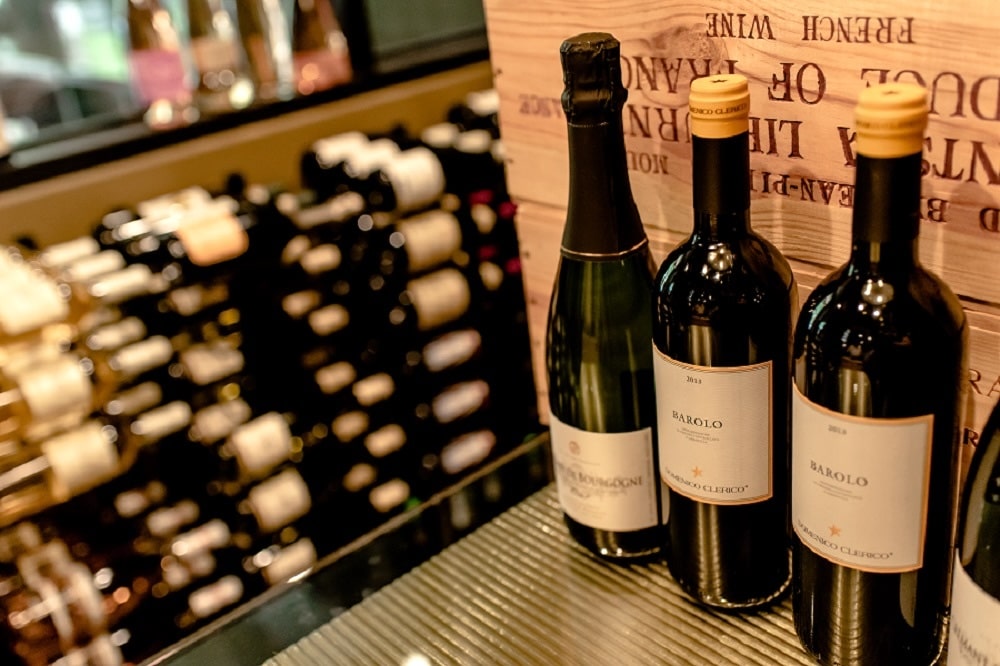
Displaying wine boxes or creates (not just wine bottles) gives any wine room that touch of character.
8) Treating visibility as an afterthought.
If guests can’t see labels, they don’t explore the list. A commercial wine room should be merchandised—clean sightlines, readable labels, and an intuitive flow for staff. (This is where glass placement, label-forward racking, and lighting design work together.)
How we fix it: Plan label-forward displays at eye level, use beam spreads matched to row spacing, and keep glass clear of glare paths.
9) Forgetting long-term operations: access, maintenance, and security.
No one wants to dismantle a display to service a coil—or discover a high-value bottle went missing. Designing for access and deterrence protects the investment and keeps service smooth.
How we fix it: Allocate service clearances, conceal or secure high-value bottles, integrate inventory routines, and discreet security where appropriate.
10) Chasing a “cellar temp” without a real target.
“Cool” isn’t a spec. Most programs aim near ~55°F with controlled humidity; the key is stability, not chasing the lowest number on a busy Friday night.
How we fix it: Program stable setpoints and train staff on door discipline and service flow so the environment stays consistent during peak hours.

This wine cellar also sits beside a “private dining room” where guests also have a full view of the wine collection.
What It Means for the Restaurant
Since finishing the project, the commercial wine room has done exactly what it was meant to do: spark curiosity, boost sales, and elevate the dining experience. Guests linger at the bar, peek into the cellar, and often order something new simply because the display inspires them.
“When people step inside and their eyes light up, that’s the best part,” Robert says with a grin.
Why We Love Building Commercial Wine Rooms
For us, this cellar isn’t just another installation. It’s a reminder of what happens when design, craftsmanship, and passion come together. Commercial wine rooms aren’t just storage—they’re experiences. They tell your story, protect your collection, and create a space guests will never forget.
Thinking about adding a commercial wine room to your restaurant, hotel, or bar?
LET’S TALK!
Our team at Wine Cellar Specialists would love to help you create a space that makes people say, “Wow.”
CONTACT US AT (323) 825-9846
OR




